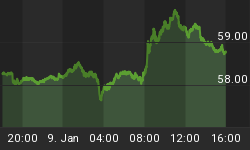Let's step back for now and take a longer-term view of the stock market. I'm talking about the next 3-5 years. Is the overall market picture bullish or bearish? Long-time readers know my opinion on that subject. But for argument's sake, let's pretend like we haven't a clue and we're approaching the market from a macro perspective, trying to get an idea of what to expect in the years immediately ahead.
The reason I'm taking you through this exercise is because of an e-mail I received this week. It probably summarizes well the confusion that many investors currently face with all the conflicting opinions out there right now. So let me start by reprinting a snippet from his letter:
"Everyone's saying contradictory things: Steven Saville shows a chart 'revealing' how we're in the very early stages of a secular bear market in his latest article. Yet you say we've got great years ahead, at least a few, viz., 3-5 in real estate, plus a 'spectacular' next leg up in stocks?! What in the world is one to think? What in heaven's name is one to do with one's capital?"
Let me interject right away by saying that I don't believe we'll necessarily see a "spectacular" leg up in stocks anytime soon. What I do believe we'll see is a recovery bull market between now and roughly 2007-2009 based on the historical pattern, plus my examination of the fundamental, technical, cyclical, and psychological data. I also believe we'll witness a bullish 2005. But I doubt the recovery bull market we're now in (and yes friends, it is a bull market -- not a bear market rally) will be as effervescent of wildly bullish as the 1980s or late '90s. This is a "recovery" rally, emphasis on recovery. Just as a man who breaks his leg in an accident must slowly recover and go slowly as he walks around everyday, so a major long-term bull market coming off a 2-3 year setback won't exactly be running around at full speed for some time. Thus, what we have is a limping bull.
Now this convalescing bull will have his good years and his not-so-good years. In a nutshell, I believe the odd numbered years will be mostly bullish while the even numbered years will be less bullish-to-bearish (again based on history). Also, you have the 12-year cycle having bottomed in 2002, which is providing a major lift to this market even as the 10-year cycle bottoms in later 2004. Then, in 2005 you'll have a rising 12-year and 10-year cycle, which should give that year a pretty good lift. In 2006 you'll see the 8-year cycle bottom later in the year, which could make for a very rocky year (similar in some respects to later 1998, the previous 8-year cycle bottom). In 2008-2009 the last of the longer-term cycles peak and from that point forward it will very likely be all downhill into 2014 when the 120-year Master Cycle (discovered by Samuel J. Kress) bottoms, along with the K-wave. So from the 12-year cycle bottom of late 2002 until around 2008-2009 we should have an overall upward bias in the stock market.
Here is a chart of the long-term S&P 500 (see MSR online page). Does this look like a bear market to you? When I look at this chart I see a bullish parabolic bowl pattern which has so far acted to shepherd the price of the S&P to higher levels in recent years. I also see that the S&P is now above its *rising* 30/60/90-week moving averages, which is bullish. By definition, a bear market is when price is below the *falling* 30/60/90-week MAs. A bull market/recovery is when price recovers above the 30/60/90s and furthermore all three moving averages are in synch together to the upside. This is the picture we now see in the S&P 500.

But don't just stop there. Notice that earnings-per-share (EPS) has been rising at a brisk pace since the 2002 low. Notice also the very reasonable price/earnings ratio. Just last year the bears were complaining "how high" the p/e ratio on the S&P was above 30. Now that the p/e has come down, what excuse are they using for their bearishness?
Following is a list of questions that I believe must be answered by the bears before they can claim we've entered a "secular" bear market:
1. The super long-term uptrend line in the Dow Industrial index is unbroken. Until it's broken, can the bears really claim we're in a bear market?
2. The 10-year moving average (very important) in the Dow was successfully tested a couple of times in 2002-2003 without breaking. It's also still rising at a good rate of change with the Dow comfortably above it. Can a major bear market be imminent as long as this is the case?
3. Fundamentally, corporate earnings growth has finally caught up with price, and earnings are mostly on the rise, with p/e ratios dropping back from their dangerously high levels from 1-2 years ago. Is this the mark of a bear market?
4. The M3 money supply has recently exploded to extraordinary levels. Historically, this has always been followed by a bull market in stocks and an economic recovery. Why will this time be any different?















